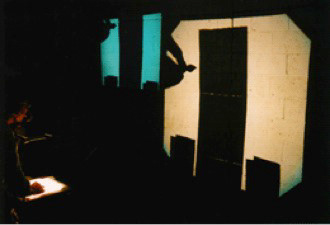Potemkin Village, the last and unfinished work of Delgado, is named after the term “Potemkin Village”, which means trickery, a magnificent façade that was built in order to cover a shameful and unwished situation. This term is based on historical facts: In 1786, Katherine the Great organized a cruise in order to celebrate the conquest of the Turkish lands situated North to the Black Sea. At the approach of the cruise, the General Potemkin ordered the building of villages along the rivers of South Russia. Many passengers noticed that the thousands of villages were but virtual; a theatrical, decorative and spectacular trick intended to impress the passengers and to justify the conquest. According to the version of Delgado, in order to present a purified and festive image the General Potemkin “cleaned” those areas from handicapped, insane persons, beggars, and independent artists. Potemkin sent them to the last ship of the cruise and organized a show on board the last day. The show became an open opposition to the aristocracy. It was named “Potemkin Village”
The Potemkin Village of Delgado tried to recapture the spirit of the historical performance while breaking conventions of acting and watching of his times. The performance was both a sharp criticism of the country situation of those days and a silent call to a fierce arising.
Sala-manca found it appropriate to reconstruct and readapt that performance and to base it on the themes that Delgado developed. Those themes are adapted by sala-manca through the mise en scene of a tour in the different rooms of the “Hazira”, during which the power relations of the spaces change.
The traditional auditorium is weakened by the emphasis on minor spaces. The stations of the tour are meant to announce the dissolution of the performance.
Review:


